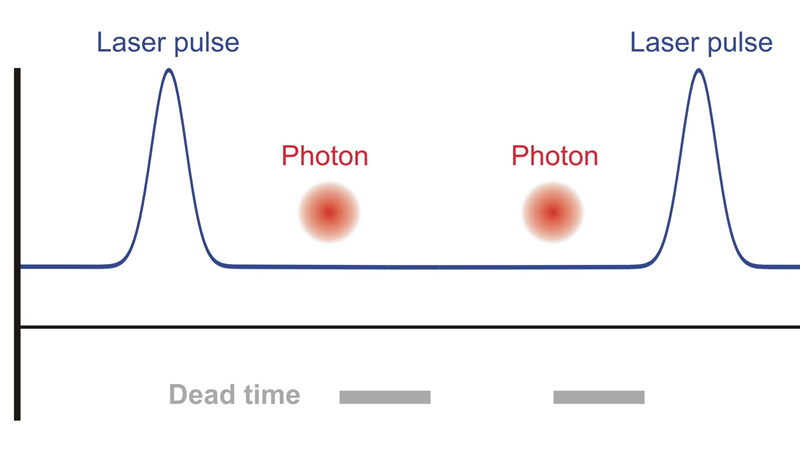TCSPC and Time Tagging Electronics
PicoHarp 330 NEW
Precise and Versatile Event Timer & TCSPC Unit
PicoHarp 330 is an Event Timer & TCSPC Unit with outstanding timing precision and versatile trigger methods made for applications with up to five channels.
- Outstanding timing precision of 2 ps RMS for single channel, 3 ps RMS between channels
- Cutting-edge time resolution of 1 ps
- Choice of edge triggers or Constant Fraction Discriminators (CFD)
- Sustained time tagging with up to 85 Mcps via USB 3.0
- Ultrashort dead time of 680 ps, no dead time across channels
- New: 4+1 channel setup with advanced channel configuration
Contact us to get a quote and for further questions.
Flexible channel configuration and synchronization
 The PicoHarp 330 is equipped with up to four identical detection channels and a common sync channel. Each channel operates independently but can synchronize with the others, depending on your needs. The common sync channel which supports up to 640 MHz ensures seamless integration with an excitation source. If no synchronization is required, the sync input can be used as an additional detection channel. This feature facilitates tasks such as coincidence correlation or coincidence counting. The PicoHarp 330 is also ideally suited for performing TCSPC with multiple detectors using forward start-stop operation.
The PicoHarp 330 is equipped with up to four identical detection channels and a common sync channel. Each channel operates independently but can synchronize with the others, depending on your needs. The common sync channel which supports up to 640 MHz ensures seamless integration with an excitation source. If no synchronization is required, the sync input can be used as an additional detection channel. This feature facilitates tasks such as coincidence correlation or coincidence counting. The PicoHarp 330 is also ideally suited for performing TCSPC with multiple detectors using forward start-stop operation.
High data quality: exceptional timing precision and time resolution
The PicoHarp 330 achieves high data quality with its intelligently designed time-to-digital converters. It features a base resolution of 1 ps, and a jitter of 2 ps RMS (single channel), and 3 ps RMS (between channels).
Detects multiple photons per cycle due to ultrashort dead time of 680 ps
With an ultrashort dead time of 680 ps using an edge trigger, the PicoHarp 330 can detect multiple events (e.g., photons registered by a detector) in quick succession, even several per excitation cycle if it is long enough. This is possible even at the highest repetition rates achievable by modern picosecond pulsed lasers. The instrument supports high measurement rates up to 85 million counts/sec over all channels (up to up to 85 million counts/sec per single channel). The USB 3.0 connectivity ensures high data throughput.
Supports widest variety of single photon detectors with choice of edge triggers or CFDs
 In order to support the widest possible variety of single photon detectors, the PicoHarp 330 provides different input circuitry. For optimal timing with e.g. Superconducting Nanowire Single Photon Detectors (SNSPD) the inputs can be configured as edge triggers while for best performance with Hybrid Photodetectors (HPD) or Micro Channel Plates (MCP) they can be configured as Constant Fraction Discriminators (CFD). This way the overall system IRF may be tuned to become narrower. The same could not be achieved with a simple level trigger (comparator). Particularly with PMTs and MCPs, constant fraction discrimination is very important as their pulse amplitudes vary significantly.
In order to support the widest possible variety of single photon detectors, the PicoHarp 330 provides different input circuitry. For optimal timing with e.g. Superconducting Nanowire Single Photon Detectors (SNSPD) the inputs can be configured as edge triggers while for best performance with Hybrid Photodetectors (HPD) or Micro Channel Plates (MCP) they can be configured as Constant Fraction Discriminators (CFD). This way the overall system IRF may be tuned to become narrower. The same could not be achieved with a simple level trigger (comparator). Particularly with PMTs and MCPs, constant fraction discrimination is very important as their pulse amplitudes vary significantly.
Don't worry about cable lengths thanks to adjustable delay on each channel
Each input channel has an internal adjustable timing offset (delay) with ±100 ns range at 1 ps resolution. This feature eliminates the need for specially adapted cable lengths or cable delays, providing flexibility and ease of use for different experimental setups.
65536 histogram bins per channel, minimum width 1 ps
The PicoHarp 330 features 65536 histogram bins per input channel, with a minimum width of 1 ps and allows the collection of over 4 billion counts (32 bits) per bin.
Multi-stop capability for efficiency
The PicoHarp 330 offers multi-stop capability, which allows registering more than one event between two subsequent sync signals. This is particularly beneficial for efficiently measuring long phosphorescence and photoluminescence lifetimes in the µs to ms range. This feature is especially relevant for materials sciences, providing versatility in experimental setups.
External synchronization signals
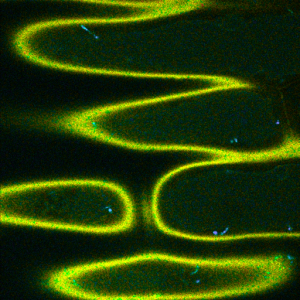 The Time-Tagged Time-Resolved (TTTR) modes supported by the PicoHarp 330 record all relevant time information of each individual photon event (e.g., photons registered by a detector). By storing this full data set, it becomes possible to carry out the most comprehensive and sophisticated analysis of photon dynamics. Additionally, the PicoHarp 330 can be synchronized with other hardware such as scanners for fluorescence lifetime imaging or with other control events when operated in TTTR mode.
The Time-Tagged Time-Resolved (TTTR) modes supported by the PicoHarp 330 record all relevant time information of each individual photon event (e.g., photons registered by a detector). By storing this full data set, it becomes possible to carry out the most comprehensive and sophisticated analysis of photon dynamics. Additionally, the PicoHarp 330 can be synchronized with other hardware such as scanners for fluorescence lifetime imaging or with other control events when operated in TTTR mode.
| Input Channels and Sync | Individiual software adjustable CFD or edge trigger on all inputs |
| Number of detector channels (in addition to Sync input) |
Up to 4 |
| Input voltage operating range (pulse peak into 50 Ohms) | -1500 mV to 1500 mV |
| Input voltage max. range (damage level) | - 2000 mV to 3000 mV |
| Trigger edge | CFD: falling edge / Edge Trigger: falling or rising edge, software adjustable |
| Time to Digital Converters | |
|---|---|
| Minimum time bin width | 1 ps |
| Timing precision* | 3 ps rms typ. |
| Timing precision / √2* | 2 ps rms typ. |
| Dead time | 680 ps for edge trigger, 4.2 ns with CFD |
| Differential non-linearity | < 10 % peak, < 1 % rms (over full measurement range) |
| Maximum sync rate (periodic pulse train) | 640 MHz |
| Histogrammer | |
| Count depth | 32 bit (4 294 967 295 counts) |
| Maximum number of time bins | 65536 (via GUI), 524288 (via DLL) |
| TTTR Engine | |
| Peak count rate per input channel | 1.47 × 109 cps for burst durations up to 1000 events |
| Sustained count rate per input channel** | 80 Mcps |
| Total sustained count rate, sum over all input channels** | 85 Mcps |
| External Marker Inputs | |
| Number | 4 |
| External Synchronization | |
| Ref IN | 10 MHz, 100 MHz, or 500 MHz 200 … 1500 mV p.p. 50 Ohm; AC coupled |
| Ref OUT | Default: 10 MHz 1000 mV 50 Ohm; DC coupled |
* In order to determine the timing precision it is necessary to repeatedly measure a time difference and to calculate the standard deviation (rms error) of these measurements. This is done by splitting an electrical signal from a pulse generator and feeding the two signals each to a separate input channel. The differences of the measured pulse arrival times are calculated along with the corresponding standard deviation. This latter value is the rms jitter which we use to specify the timing precision. However, calculating such a time difference requires two time measurements. Therefore, following from error propagation laws, the single channel rms error is obtained by dividing the previously calculated standard deviation by √(2). We also specify this single channel rms error here for comparison with other products.
** Sustained throughput depends on configuration and performance of host PC.
All Information given here is reliable to our best knowledge. However, no responsibility is assumed for possible inaccuracies or omissions. Specifications and external appearances are subject to change without notice.
Time traces
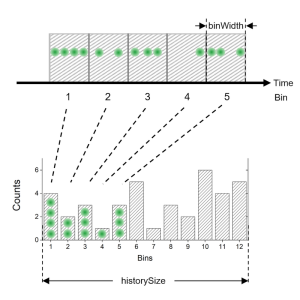 Are your quantum dots, nanoparticles, or single fluorophores blinking? Should they? Is your setup well adjusted and sensitive enough for the measurements you want to perform? An easy way to find out is to acquire high-resolution intensity time traces with single photon counting. You can calculate time traces with incoming photons in parallel channels, view them live, and do much more. A typical example is the blinking of single Cy5 molecules.
Are your quantum dots, nanoparticles, or single fluorophores blinking? Should they? Is your setup well adjusted and sensitive enough for the measurements you want to perform? An easy way to find out is to acquire high-resolution intensity time traces with single photon counting. You can calculate time traces with incoming photons in parallel channels, view them live, and do much more. A typical example is the blinking of single Cy5 molecules.
Histogramming
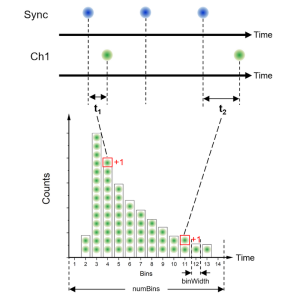 Photoluminescence is an intrinsic property of many materials, including semiconductors, novel 2D materials, and quantum dots. The photoluminescence lifetime can provide valuable information about sample composition and homogeneity, the local chemical environment inside the sample, or dynamic processes and reaction mechanisms.
Photoluminescence is an intrinsic property of many materials, including semiconductors, novel 2D materials, and quantum dots. The photoluminescence lifetime can provide valuable information about sample composition and homogeneity, the local chemical environment inside the sample, or dynamic processes and reaction mechanisms.
To measure time-resolved photoluminescence precisely in the range of ps to ms, you can record photoluminescence decays with incoming photons in parallel channels, view them live, and do much more.
A typical example is the time-resolved photoluminescence decays that reveal charge carrier dynamics in semiconductors.
Coincidence correlation for antibunching
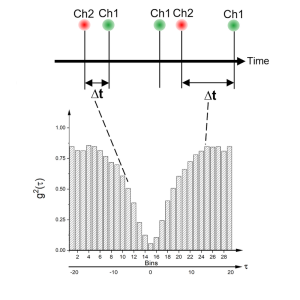 Coincidence correlation measurements are a fundamental technique in quantum optics and quantum mechanics. Their purpose is to study the statistical correlations between photon arrival times, which can prove the presence of a single photon emitter or verify quantum entanglement. Coincidence correlations are important for various practical applications in quantum communication, cryptography, and imaging.
Coincidence correlation measurements are a fundamental technique in quantum optics and quantum mechanics. Their purpose is to study the statistical correlations between photon arrival times, which can prove the presence of a single photon emitter or verify quantum entanglement. Coincidence correlations are important for various practical applications in quantum communication, cryptography, and imaging.
A typical example is the antibunching trace of individual Nitrogen Vacany centers in nanodiamonds.
Coincidence correlation for FCS
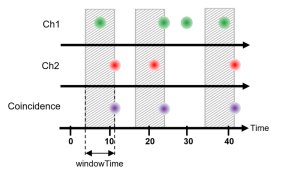 How to probe the behavior of molecules and particles in materials at the nanoscale in a non-invasive manner? Fluorescence correlation spectroscopy (FCS) is a versatile tool to study the dynamics of materials at the nanoscale in diverse application areas, for example:
How to probe the behavior of molecules and particles in materials at the nanoscale in a non-invasive manner? Fluorescence correlation spectroscopy (FCS) is a versatile tool to study the dynamics of materials at the nanoscale in diverse application areas, for example:
- diffusion and mobility – understanding transport phenomena in porous materials
- size, shape and concentration of nanoparticles for drug delivery and catalysis
- dynamics of polymer chains for use in composites, adhesives, or coatings
- formation and properties of micelles for use in emulsions and colloidal stability
Arrival times of single photons from intrinsically luminescent or fluorescently labeled samples are recorded with PicoQuant‘s time tagging electronics. You can perform real-time coincidence correlation with incoming photons, view FCS curves live, and do much more.
A typical example is how fluorescence lifetime information improves cross-correlation spectroscopy of double-stranded DNA.
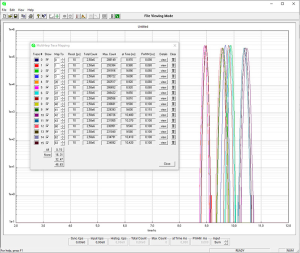 Windows software included
Windows software included
The PicoHarp 330 comes with a Windows software package that provides all important functions such as setting measurement parameters, displaying results, loading / saving of measurement parameters and measurement curves. Important measurement data, including count rate, count maximum, position and peak width are continuously displayed.
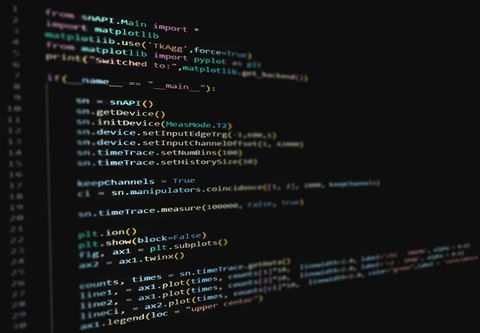 Custom programming supported
Custom programming supported
A library for custom programming, e.g., with C, C#, LabVIEW, Matlab, and Python is included. Demo code is provided for an easy start.
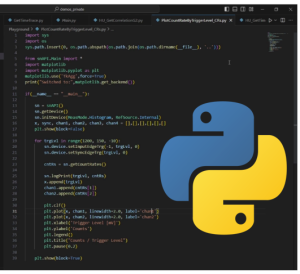 Python wrapper snAPI
Python wrapper snAPI
Fast, intuitive, and versatile snAPI serves as a bridge between the capabilities of PicoQuant's TCSPC devices and the Python ecosystem, offering efficient device communication, configuration, and data handling for all users.
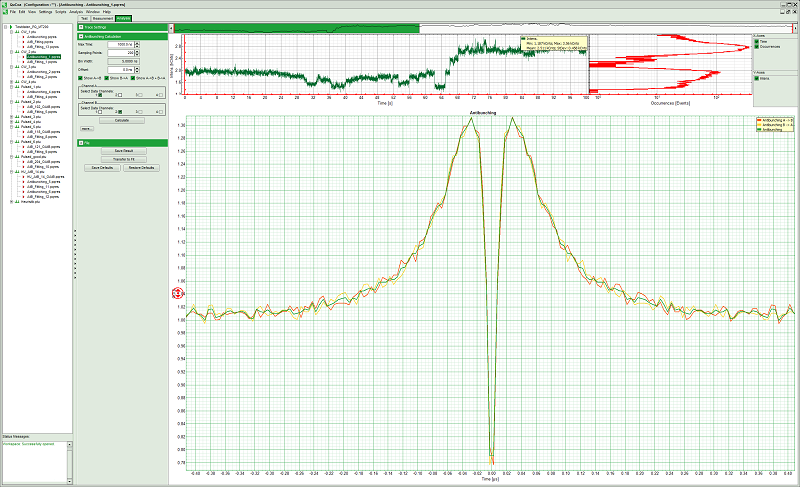 QuCoa
QuCoa
The PicoHarp 330 is supported by the QuCoa software package, which is an integrated solution for data acquisition and analysis. It is mainly targeted at research areas that rely on quantum correlation analysis such as coincidence detection in a Hanbury-Brown-Twiss setups, or the study of entanglement using Hong-Ou Mandel setups, to name only a few.
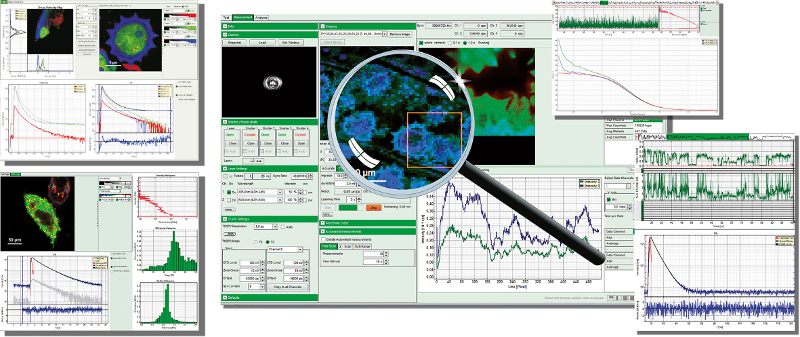 SymPhoTime 64
SymPhoTime 64
The PicoHarp 330 is supported by the SymPhoTime 64 software package, which is an integrated solution for data acquisition and analysis. It is mainly targeted at microscopy based applications such as imaging (FLIM, FLIM-FRET), correlation (FCS, FCCS, FLCS, PIE-FCS) or fluorescence time trace analysis.
The PicoHarp 330 can be used for various applications that can make use of a TCSPC and/or time tagging system with independent channels, such as:
- Time-Resolved Fluorescence
- Fluorescence Lifetime Imaging (FLIM)
- Phosphorescence Lifetime Imaging (PLIM)
- Fluorescence Correlation Spectroscopy (FCS)
- Fluorescence Lifetime Correlation Spectroscopy (FLCS)
- Foerster Resonance Energy Transfer (FRET)
- Stimulated Emission Depletion Microscopy (STED)
- Dual Focus Fluorescence Correlation Spectroscopy (2fFCS)
- Pulsed Interleaved Excitation (PIE)
- Fluorescence Anisotropy (Polarization)
- Singlet Oxygen
- Time-Resolved Photoluminescence (TRPL)
- Time-Resolved Cathodoluminescence
- Single Molecule Spectroscopy/DetectionTRPL Imaging
- Lanthanide Upconversion
- Bunch Purity
- LIDAR/Ranging/SLR
- Antibunching
- Coincidence Correlation
- Quantum Communication
- Quantum Entanglement
- Quantum Teleportation
- Quantum Information Processing
- Positron Annihilation Lifetime Spectroscopy (PALS)
- Thomas-Bollinger single photon method
- Diffuse Optical Tomography and Imaging
- Linear Optical Quantum Computation
- TD-fNIRS
- Multi-color Lifetime Imaging
- Intensity interferometry
- Time Interval Analysis (TIA)



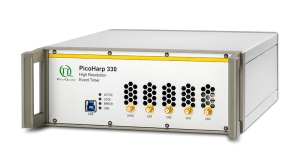
 Contact us
Contact us